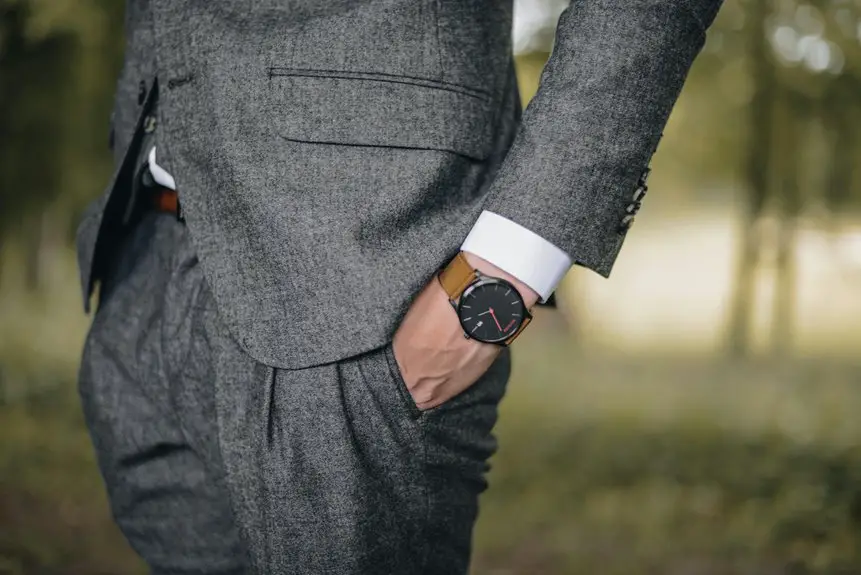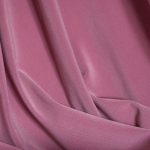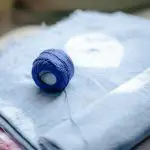You wear corduroy pants because they combine durability and style with a rich cultural history. Originating as tough workwear centuries ago, corduroy became popular in the 20th century among students and outdoor enthusiasts. Intellectuals and indie musicians embraced it for its vintage charm and nonconformity. Today, modern fabrics and fresh designs bring corduroy back in new, stylish ways. Keep exploring and you’ll uncover how this classic fabric continues to evolve and inspire fashion trends.
Table of Contents
Key Takeaways
- Corduroy fabric originated centuries ago as a durable textile for workwear and upholstery with its distinctive ridged texture.
- In the 20th century, corduroy pants gained popularity among students, intellectuals, and outdoor enthusiasts for casual and semi-formal wear.
- Various cultural groups embraced corduroy pants to express identity, including intellectuals, hippies, and indie musicians.
- Modern corduroy features lighter, stretch-enhanced blends and advanced dyeing techniques for improved comfort and vibrant colors.
- Contemporary styling favors slim or wide-leg corduroys in earth tones, paired with minimal accessories and layered with denim or blazers.
Origins and Early Uses of Corduroy Fabric
Although corduroy fabric dates back several centuries, you might be surprised to learn how it first gained popularity.
Originally, corduroy was crafted as a durable textile, prized for its distinctive ridged texture, or “wales.” You’d find it primarily used in workwear because it could withstand rough conditions and frequent use.
Corduroy’s durable ridged texture made it a staple in workwear for tough, everyday use.
Early on, tailors favored corduroy for making sturdy trousers and jackets, especially in rural and industrial settings. Its thick cotton weave provided warmth, making it ideal for outdoor laborers.
You’d also notice corduroy in upholstery and furnishings, thanks to its resilience and unique appearance.
While its exact origins are debated, you can trace its roots back to Europe and Asia, where similar fabrics were woven to meet practical needs rather than fashion trends.
Corduroy’s Rise in 20th Century Fashion
As corduroy moved beyond its practical roots, it quickly caught the attention of fashion designers and everyday wearers alike during the 20th century.
You’d notice corduroy’s versatility made it a favorite for casual and semi-formal clothing. Designers embraced its texture and durability, incorporating it into jackets, skirts, and especially pants.
In the 1920s and ’30s, corduroy pants became popular among students and intellectuals, signaling a smart yet relaxed style. By mid-century, corduroy’s appeal grew, partly due to its association with outdoor activities and comfortable workwear.
You’ll find it resurfacing repeatedly in fashion cycles, adapting to trends but always maintaining its distinct ribbed look.
Wearing corduroy pants today, you tap into a rich history of practicality meeting style.
Cultural Associations and Subcultural Adoption
When you look at corduroy pants, you see more than just fabric; you see a symbol embraced by various cultural groups. From the academic circles of the 1960s to the indie music scene of the 1990s, corduroy has been a statement of identity. You’ll notice it’s not just about style but also about what the pants represent — comfort, intellect, or rebellion.
| Cultural Group | Why They Adopted Corduroy |
|---|---|
| Intellectuals | Symbol of scholarly, vintage charm |
| Hippies | Earthy, natural appeal |
| Indie Musicians | Nonconformity and retro vibe |
Modern Innovations and Corduroy’s Revival
While corduroy once faced a decline in popularity, you’ll find it making a strong comeback thanks to innovative fabrics and modern designs that blend comfort with style.
Today’s corduroy pants often use lighter, stretch-enhanced blends that improve fit and movement, making them more appealing for everyday wear. Advanced dyeing techniques also deliver richer colors and better color retention, so your corduroy stays vibrant longer.
Designers now experiment with varied wale widths and unexpected silhouettes, updating the classic look without losing its signature texture. You can appreciate how these innovations transform corduroy from a nostalgic fabric into a versatile, contemporary wardrobe staple.
This revival proves corduroy’s enduring appeal, adapting to modern tastes without sacrificing its unique character.
Styling Tips and Contemporary Trends With Corduroy Pants
Because corduroy pants offer both texture and warmth, you can easily create outfits that balance comfort with style.
Try pairing slim-fit corduroys with a crisp white shirt and leather loafers for a polished look. For casual days, match wide-leg corduroys with a cozy knit sweater and sneakers.
Don’t shy away from experimenting with colors—earth tones like olive, rust, and mustard are trendy and versatile. Layering works well too; throw on a denim jacket or a tailored blazer to elevate your ensemble.
Accessorize minimally to let the fabric stand out. Whether you go for vintage-inspired or modern minimalist, corduroy pants adapt to your personal vibe, making them a must-have in your wardrobe.
Embrace current trends by mixing textures and keeping your silhouette balanced.
Frequently Asked Questions
How Is Corduroy Fabric Manufactured Today?
You start by weaving cotton or cotton blends into a base fabric, then cut extra yarns to create raised cords or wales. Finally, you wash and finish the fabric for softness and durability before making garments.
What Are the Environmental Impacts of Corduroy Production?
Think of corduroy production as a river with hidden pollutants; it consumes water and energy, releases chemicals, and produces waste. You can reduce its impact by choosing sustainably made fabrics and supporting eco-friendly brands.
Can Corduroy Be Recycled or Upcycled Effectively?
You can definitely recycle or upcycle corduroy effectively. Its sturdy fabric holds up well, making it perfect for crafting new garments or accessories. Just make sure to clean and repair it before repurposing.
How Do Corduroy Fabrics Differ Globally?
You might think corduroy’s texture stays the same worldwide, but it varies with local cotton quality, weaving techniques, and thickness. These factors shape its durability, feel, and appearance, making each region’s fabric unique.
What Are the Care Instructions to Maintain Corduroy Pants?
You should wash corduroy pants inside out in cold water, use a gentle cycle, and avoid bleach. Hang them to dry or tumble dry low. Iron on the reverse side to keep the fabric smooth and vibrant.
- When Is It Too Late to Wear Corduroy? A Seasonal Guide - July 5, 2025
- Understanding Corduroy Trousers: A Guide to This Classic Fabric - July 5, 2025
- Style Guide: How to Wear a Corduroy Sherpa Jacket Effectively - July 5, 2025







